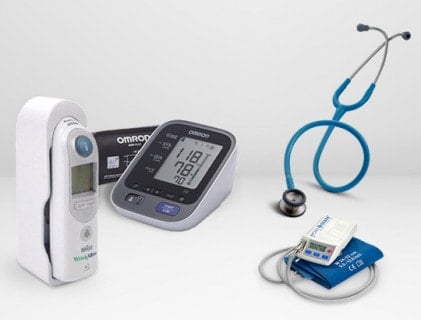In the rapidly evolving field of medicine, diagnostic tools are the unsung heroes that allow healthcare professionals to pinpoint ailments, monitor health, and provide effective treatments. From simple instruments to sophisticated machines, these tools are vital for accurate and timely medical intervention. This blog post will take you on a journey through the modern medical toolbox, highlighting key diagnostic tools that shape today’s healthcare landscape.
1. Stethoscopes: The Classic Diagnostic Tool
Often considered a symbol of the medical profession, the stethoscope is one of the most fundamental diagnostic tools. Invented in the early 19th century, it remains indispensable for physicians.
A stethoscope allows doctors to listen to internal sounds of a patient’s body, such as the heartbeat, lung sounds, and bowel noises. By analyzing these sounds, healthcare providers can identify abnormalities like murmurs, crackles, or wheezes, which can be critical in diagnosing conditions such as heart disease or pneumonia.
2. Thermometers: Measuring Body Temperature
Thermometers are essential for assessing body temperature, a vital sign that can indicate fever or hypothermia. Modern thermometers come in various forms, including digital, infrared, and mercury.
Digital thermometers are widely used for their accuracy and ease of use. Infrared thermometers, often used in hospitals and clinics, provide quick temperature readings without direct contact, making them ideal for assessing body temperature in a non-invasive manner.
3. Blood Pressure Monitors: Tracking Cardiovascular Health
Blood pressure monitors, or sphygmomanometers, are crucial for diagnosing and managing hypertension, a condition that can lead to serious health problems if left untreated. Manual blood pressure monitors, which involve a cuff and a stethoscope, are still used in many clinical settings.
However, automatic or digital blood pressure monitors have become more common due to their convenience and ease of use. These devices provide consistent readings that help healthcare providers assess a patient’s cardiovascular health and make informed treatment decisions.
4. Glucometers: Managing Blood Sugar Levels
For individuals with diabetes, monitoring blood sugar levels is an essential part of daily life. Glucometers, or blood glucose meters, are compact devices that measure the concentration of glucose in a blood sample.
Modern glucometers are user-friendly and offer features such as memory storage and connectivity to health apps, allowing patients and healthcare providers to track blood sugar levels over time and adjust treatment plans accordingly.
5. X-Ray Machines: Visualizing Internal Structures
X-ray machines are a cornerstone of medical imaging, providing detailed images of the internal structures of the body. X-rays are particularly useful for diagnosing bone fractures, infections, and certain tumors.
While traditional X-ray machines are still widely used, advancements in technology have led to the development of digital X-rays, which offer quicker imaging, reduced radiation exposure, and improved image quality. Digital X-rays also facilitate easier sharing and storage of images, enhancing collaborative care.
6. Ultrasound Machines: Real-Time Imaging
Ultrasound machines use high-frequency sound waves to create real-time images of internal organs and tissues. This non-invasive imaging technique is valuable for monitoring pregnancies, diagnosing abdominal issues, and guiding certain medical procedures.
Modern ultrasound machines offer advanced features such as 3D imaging and Doppler ultrasound, which can assess blood flow and detect abnormalities with greater precision.
7. CT Scanners: Detailed Cross-Sectional Imaging
Computed Tomography (CT) scanners provide detailed cross-sectional images of the body, allowing for a comprehensive view of internal structures. CT scans are instrumental in diagnosing complex conditions, such as internal injuries, tumors, and neurological disorders.
The advent of multi-slice CT scanners has significantly improved imaging speed and resolution, providing high-quality images for more accurate diagnoses.
8. MRI Machines: High-Resolution Imaging
Magnetic Resonance Imaging (MRI) machines utilize powerful magnets and radio waves to produce detailed images of soft tissues, organs, and structures within the body. MRI is particularly useful for diagnosing conditions affecting the brain, spinal cord, and joints.
Unlike CT scans, MRI does not use ionizing radiation, making it a safer option for certain patients. Advanced MRI technologies, such as functional MRI (fMRI), also offer insights into brain activity and function.
9. Endoscopes: Internal Exploration
Endoscopes are flexible, tube-like instruments equipped with a camera and light source, allowing doctors to visualize the interior of body cavities and organs. They are commonly used in procedures such as colonoscopies, gastroscopies, and bronchoscopies. Endoscopes enable healthcare providers to diagnose and treat conditions directly, often with minimal invasiveness and quicker recovery times.
10. Laboratory Diagnostic Tools: Analyzing Biological Samples
Laboratory diagnostic tools are crucial for analyzing blood, urine, and other biological samples. Techniques such as blood tests, urinalysis, and microbiological cultures help diagnose a wide range of conditions, from infections to metabolic disorders.
Advanced lab equipment, including automated analyzers and molecular diagnostic tools, enhances the speed and accuracy of test results, supporting timely and effective medical decisions.
Conclusion
The contemporary medical toolbox comprises a wide array of diagnostic tools that are essential to modern healthcare. Ranging from traditional stethoscopes to state-of-the-art MRI machines, each instrument brings unique functionalities that are crucial for precise diagnosis and effective treatment. As technology evolves, we anticipate the introduction of even more advanced diagnostic tools, enhancing our capability to identify, monitor, and manage various health conditions.
This sophisticated toolkit, which increasingly incorporates innovations such as pneumatic fittings for improved functionality and efficiency, not only underscores the advancements in medical technology but also reflects the ongoing dedication to elevating patient care and outcomes.













